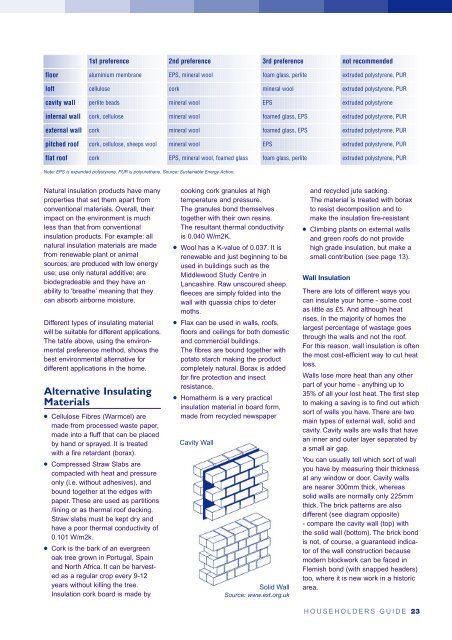improving and decorating your home
You also want an ePaper? Increase the reach of your titles
YUMPU automatically turns print PDFs into web optimized ePapers that Google loves.
1st preference 2nd preference 3rd preference not recommended<br />
floor aluminium membrane EPS, mineral wool foam glass, perlite extruded polystyrene, PUR<br />
loft cellulose cork mineral wool extruded polystyrene, PUR<br />
cavity wall perlite beads mineral wool EPS extruded polystyrene<br />
internal wall cork, cellulose mineral wool foamed glass, EPS extruded polystyrene, PUR<br />
external wall cork mineral wool foamed glass, EPS extruded polystyrene, PUR<br />
pitched roof cork, cellulose, sheeps wool mineral wool EPS extruded polystyrene, PUR<br />
flat roof cork EPS, mineral wool, foamed glass foam glass, perlite extruded polystyrene, PUR<br />
Note: EPS is exp<strong>and</strong>ed polystyrene, PUR is polyurethane. Source: Sustainable Energy Action.<br />
Natural insulation products have many<br />
properties that set them apart from<br />
conventional materials. Overall, their<br />
impact on the environment is much<br />
less than that from conventional<br />
insulation products. For example: all<br />
natural insulation materials are made<br />
from renewable plant or animal<br />
sources; are produced with low energy<br />
use; use only natural additive; are<br />
biodegradeable <strong>and</strong> they have an<br />
ability to ‘breathe’ meaning that they<br />
can absorb airborne moisture.<br />
Different types of insulating material<br />
will be suitable for different applications.<br />
The table above, using the environmental<br />
preference method, shows the<br />
best environmental alternative for<br />
different applications in the <strong>home</strong>.<br />
Alternative Insulating<br />
Materials<br />
●<br />
●<br />
●<br />
Cellulose Fibres (Warmcel) are<br />
made from processed waste paper,<br />
made into a fluff that can be placed<br />
by h<strong>and</strong> or sprayed. It is treated<br />
with a fire retardant (borax).<br />
Compressed Straw Slabs are<br />
compacted with heat <strong>and</strong> pressure<br />
only (i.e. without adhesives), <strong>and</strong><br />
bound together at the edges with<br />
paper. These are used as partitions<br />
/lining or as thermal roof decking.<br />
Straw slabs must be kept dry <strong>and</strong><br />
have a poor thermal conductivity of<br />
0.101 W/m2k.<br />
Cork is the bark of an evergreen<br />
oak tree grown in Portugal, Spain<br />
<strong>and</strong> North Africa. It can be harvested<br />
as a regular crop every 9-12<br />
years without killing the tree.<br />
Insulation cork board is made by<br />
●<br />
●<br />
●<br />
cooking cork granules at high<br />
temperature <strong>and</strong> pressure.<br />
The granules bond themselves<br />
together with their own resins.<br />
The resultant thermal conductivity<br />
is 0.040 W/m2K.<br />
Wool has a K-value of 0.037. It is<br />
renewable <strong>and</strong> just beginning to be<br />
used in buildings such as the<br />
Middlewood Study Centre in<br />
Lancashire. Raw unscoured sheep<br />
fleeces are simply folded into the<br />
wall with quassia chips to deter<br />
moths.<br />
Flax can be used in walls, roofs,<br />
floors <strong>and</strong> ceilings for both domestic<br />
<strong>and</strong> commercial buildings.<br />
The fibres are bound together with<br />
potato starch making the product<br />
completely natural. Borax is added<br />
for fire protection <strong>and</strong> insect<br />
resistance.<br />
Homatherm is a very practical<br />
insulation material in board form,<br />
made from recycled newspaper<br />
Cavity Wall<br />
Solid Wall<br />
Source: www.est.org.uk<br />
●<br />
<strong>and</strong> recycled jute sacking.<br />
The material is treated with borax<br />
to resist decomposition <strong>and</strong> to<br />
make the insulation fire-resistant<br />
Climbing plants on external walls<br />
<strong>and</strong> green roofs do not provide<br />
high grade insulation, but make a<br />
small contribution (see page 13).<br />
Wall Insulation<br />
There are lots of different ways you<br />
can insulate <strong>your</strong> <strong>home</strong> - some cost<br />
as little as £5. And although heat<br />
rises, in the majority of <strong>home</strong>s the<br />
largest percentage of wastage goes<br />
through the walls <strong>and</strong> not the roof.<br />
For this reason, wall insulation is often<br />
the most cost-efficient way to cut heat<br />
loss.<br />
Walls lose more heat than any other<br />
part of <strong>your</strong> <strong>home</strong> - anything up to<br />
35% of all <strong>your</strong> lost heat. The first step<br />
to making a saving is to find out which<br />
sort of walls you have. There are two<br />
main types of external wall, solid <strong>and</strong><br />
cavity. Cavity walls are walls that have<br />
an inner <strong>and</strong> outer layer separated by<br />
a small air gap.<br />
You can usually tell which sort of wall<br />
you have by measuring their thickness<br />
at any window or door. Cavity walls<br />
are nearer 300mm thick, whereas<br />
solid walls are normally only 225mm<br />
thick. The brick patterns are also<br />
different (see diagram opposite)<br />
- compare the cavity wall (top) with<br />
the solid wall (bottom). The brick bond<br />
is not, of course, a guaranteed indicator<br />
of the wall construction because<br />
modern blockwork can be faced in<br />
Flemish bond (with snapped headers)<br />
too, where it is new work in a historic<br />
area.<br />
HOUSEHOLDERS GUIDE 23



